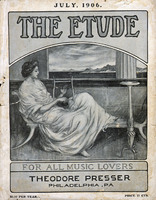BY E. R. STUBER.
How often does one hear the remark, “I should like Mr. So-and-So’s playing, but his chords are so hard.” Over and over again a musician, whose work is good in other respects, spoils his reputation by the hardness of his chords. They fall flat; and the more force he uses, the more the effect is as if he were playing on a mahogany table instead of a musical instrument. Bang, bang, bang one hears; but no resonance. In England, nineteen persons out of twenty say, “I like soft playing, best.” No wonder when their ears are assailed by such hard fortissimo playing. And yet it would be ludicrous if they could have their way, and all playing were soft.
The first time I heard Mr. Leonard Borwick I was astonished at his chords. “How does he do it?” I said. The chord did not seem to be struck at all, but grew out of the building somewhere, and filled the air with sound, being really much louder than the banging of many artists. It was one of Frau Clara Schumann’s clever tricks; but he, of all her pupils, seemed to have brought it to perfection.
I took lessons in this school for some time; but either I was uncommonly stupid, or the teacher would’nt tell all the secret, for I only learned to make furious gymnastics with my body, and the chords wouldn’t come, except by accident. Sometimes I did it beautifully, but didn’t know how.
During two years in Leipzig, I compared notes with the students, and found no teacher satisfactory as to chords. They were all hard, more or less; and none knew the secret.
I then heard Godowsky play; or saw him play, which was more to the purpose. I spoke of it to a doctor who was studying the muscles with regard to piano playing. He told me the why, I saw for myself the how.
When Godowsky plays a loud chord, he lifts himself right off the chair. The effect is amusing, but he lets out the secret thereby. In a week I had the chords I had been seeking all those years. Here are some suggestions for chord playing:
First. Don’t strike them at all.
Second. The right movement must come from pushing. Any movement from the arm alone will produce a bad, hard, flat chord.
Put your hands on the table, the tips of the fingers only touching. Sit loosely. Now, push the table without raising your fingers, and without stiffening. The jerk should send your shoulders up and your back straight. That is the right movement. Push, and nothing happens. You have stiffened; that is the wrong movement. Try again and again. Your shoulders go up every time. Right. Now come to the piano.
Put your finger tips on the chord of C, both hands. Now, hands loose, wrists loose, arms loose, shoulders loose—PUSH! Ah, you have stiffened. Try again— push. There is the right chord, feeble of course; but doesn’t it resound? Practice until you get a loud chord, but for your life, don’t stiffen. Try each hand separately when alone, using the other hand to feel if total looseness is there.
In a week your chords will be first rate. Then, take some chord study, and get it up to time. You can’t at first, because you have been used to so much preparation, but quickness will come. You will learn to relax the muscles and push at lightning speed.
You raise the objection that great players strike chords from the air with arms at a height from the piano. They do; but you can’t see what swift preparation is going on in those arm muscles as they descend. They don’t tell you that. When the arm is down it is all ready for the final grip. If it is a grand, big resounding chord, it is by some method similar to the one I have described. Hitting will never produce satisfactory results. This is a mechanical fact, and not a matter of opinion.



